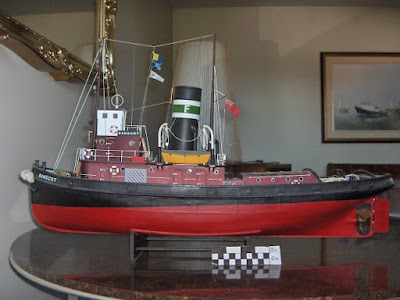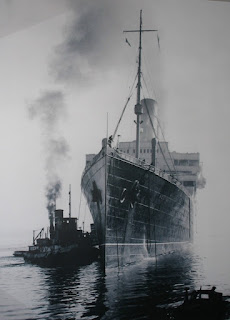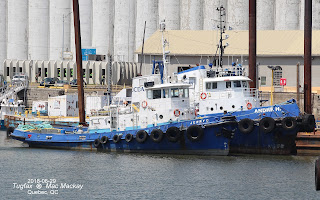Before getting to the core of this series it is necessary to set a bit more of the background. As stated before, the Foundation Company of Canada established itself in Montreal in about 1910, with several pieces of floating plant including crane barges and workboats. In 1935 its subsidiary Foundation Maritime Ltd purchased the Nova Scotia Tug Boat Company and its Halifax waterfront piers. Nova Scotia Tug Boat, which had only been founded in 1934, had a collection of older harbour tugs, most of which were scrapped or sold at the time of the purchase by Foundation. It also owned three new or fairly new steam tugs.
Foundation needed a proper base of operations in Halifax for its salvage tug Foundation Franklin, including warehouse space, machine shop and maintenenace facilities It also needed smaller tugs for its construction business and to handle salvaged ships once they arrived in port.
[This is not intended as a full or complete corporate history of the Foundation Company - just some notes on the tugs. Nova Scotia Tug Boat was tied into the Frank M. Ross companies in Montreal and Saint John - see below, but that connection remains murkey and is the subject of ongoing research.]
A new company called Maritime Towing and Salvage Ltd was formed to operate the remaining tugs in Halifax harbour. These included three tugs built by Alexander Hall in Aberdeen, Scotland. Bonscot which was renamed Banscot in 1936 ( "Ban" being Scots Gaelic for "woman"), Banshee (Scots Gaelic for "fairy woman"), both built in 1934 and the Coalopolis also built by Hall but in 1923, which was renamed Bansurf. Another tug, the G.S.Mayes, built in 1913 was included in the fleet and was renamed Bansaga. Also included was the Olearylee of 1915 vintage, which was renamed Banspray.
The primary tugs were of course the Banscot and Banshee which were rated at 900 ihp - and were very powerful for their time. The Maritime Museum of the Atlanitc model shows that the Banscot was fitted with RDF and wireless, so was intended for some coastal voyages and salvage assistance for smaller ships.
The Foundation Frances at the salvage pier with Banstar or Bansun alongside the tug dock, equipped with its rope "pudding" or bow fender.
In its pre Foundation days, the steam tug Sandusky, built in 1912, worked for the huge "G Tug" fleet of Great Lakes Towing. Intended for work in fresh water its steam plant was non-condensing, and drew lake water for its boiler. Once it came to salt water service it had to stop frequently to take on fresh water, as salt water would fill the boiler tubes with scale.
As soon as diesel engines were available Foundation re-powered the Sandusky. Renamed Banstar it was a sister tug to Bansun ex Waukegan which was similarly converted.
Foundation also acquired several Glen class tugs, built orginally for naval dockyard use, they were 350 bhp to 400 bhp (and maybe 600 bhp on a good day) with limited coastal range.
They were put to use as harbour tugs in Halifax in the winter, but in summer they were transferred to Baie-Comeau and Port Alfred.
Foundation also acquired a large 1000 ihp steam tug, which they renamed Foundation Vera. [The "V" series names began with this tug, named for the manager's wife, but later to denote Victory for the Allies in World War II. The Foundation Victor and Valour were the first to make direct reference to wartime.]
[Foundation Vera is also pictured in Post 1]
Built in 1945 by Midland Shipbuilding + Engineering as the standard tug Rockhill it became the Maritime Guardian from 1945 to 1948 until bought by Foundation. Although ten years newer than the Banscot it was very similar, and performed duties as a harbour tug in Halifax and did coastal towing and salvage work.By 1960 however, it was apparent that these relics were no longer suitable for the job. Steam tugs were inefficient and the 350 to 400 bhp diesels were not powerful enough. (On one arrival of the Queen Mary in Halifax in 1953 it took six tugs to get the ship alongside.)
It was not unusual to require four tugs or more for other big passenger liners such as the Aquitania.New diesel tugs were obviously needed. Experience with the Foundation Victor, Foundation Valour and Foundation Vibert must have played some part in the selection of the new design, and it is also likely that Davie Shipbuilding's experience with their new Quebec harbour tugs also came into play. (CSL owned both Davie and Quebec Tugs)
Robert B No.1
Jerry G
For an excellent album of Foundation tugs with many vessel particulars, see Sandy McClearn's Haze Grey and Underway feature: Foundation Tugs
.










